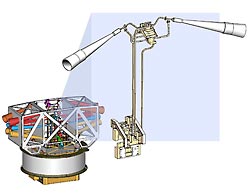
Measuring Accuracy
Anisotropy - differential vs. absolute
The Wilkinson Microwave Anisotropy Probe measures the differences in temperature of the Cosmic Microwave Background Radiation between two different points in the sky rather than the absolute temperature values themselves. This is because differential measurements of the CMB are much more accurate than absolute measurements. To illustrate this, students should separate into pairs and conduct the following experiment (each pair of students needs one small ruler -- the smaller the better):
Students take turns measuring each other's height using their small rulers. After recording the height of each student, the lower value is subtracted from the higher to find the difference in height between the two students.
For this step, each pair of students should work with another pair. The first pair of students stand back-to-back while the other pair measures the difference in their height and records it. Then, the first pair records the difference in height of the second pair of students.
After comparing the two values for the difference in height, students should be encouraged to discuss why the values are so different. What possible sources of error could there be? Which value do they think is more accurate and why?
This experiment demonstrates very simply why WMAP measures anisotropy rather than absolute temperatures: there is much less possible error with a differential measurement. By measuring very small differences in opposite directions and comparing the two numbers simultaneously, the final answer can be accurate to 1,000,000th of a degree using WMAP's "ruler".



